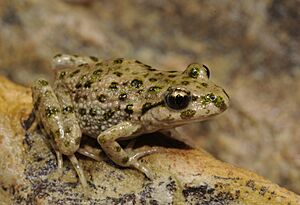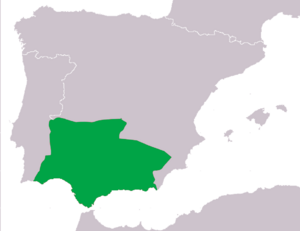Iberian parsley frog facts for kids
Quick facts for kids Iberian parsley frog |
|
|---|---|
 |
|
| Conservation status | |
| Scientific classification | |
| Genus: |
Pelodytes
|
| Species: |
ibericus
|
 |
|
The Iberian parsley frog (Pelodytes ibericus) is a small, green-speckled frog. It belongs to a group of frogs called "parsley frogs." You can only find this special frog in Portugal and Spain. In Spanish, people call it sapillo moteado ibérico.
Contents
What Does the Iberian Parsley Frog Look Like?
Adult Iberian parsley frogs are quite small. They grow to about 4 centimeters long. They look a lot like their close relative, the common parsley frog. But the Iberian parsley frog is a bit smaller. It also has shorter legs.
Their skin can be smooth or a bit bumpy. It has small, dark bumps called tubercles. The frog's back can be olive, greenish-brown, dark brown, or greenish-grey. It always has green speckles, like parsley! Its belly is white or cream. When male frogs are ready to breed, their throats turn a darker color.
Where Do Iberian Parsley Frogs Live?
The Iberian parsley frog is found only in the Iberian Peninsula. This means it is endemic to that area. It is quite common in many parts of Spain. However, it seems to be rare in Portugal.
These frogs live in many different places. You can find them in open areas, under bushes, or among scattered trees. They also live in salt marshes, fields, and even gardens. They can even survive in areas where farms are very active.
Life Cycle and Reproduction
Iberian parsley frogs usually breed in the spring. This often happens after heavy rain. They lay their eggs in ponds, ditches, or slow-moving streams. Flooded areas are also good places for eggs.
A female frog can lay up to 350 eggs at once. She might lay several groups of eggs over a few days. The eggs hatch after about two weeks. The baby frogs, called tadpoles, take about three months to grow. After this, they change into young frogs. This change is called metamorphosis.
How Are Iberian Parsley Frogs Protected?
The Iberian parsley frog lives in a wide area. Its total population seems to be quite stable. The International Union for Conservation of Nature (IUCN) studies animals around the world. They have listed this frog as "Least Concern." This means they don't think it's in danger right now. They believe its numbers are not dropping fast enough to be worried.
However, there are still some threats to these frogs. Their homes can be damaged or lost. The pools where they breed can disappear. Also, an invasive freshwater crayfish, Procambarus clarkii, eats the frogs.


